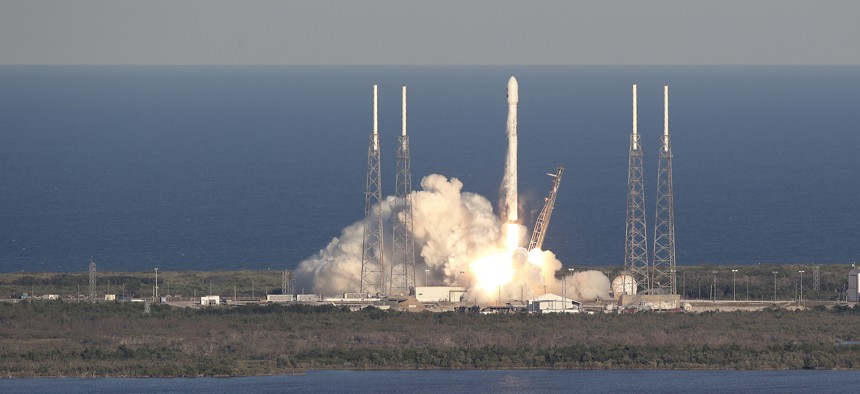
A SpaceX Falcon 9 rocket transporting the Tess satellite lifts off from launch complex 40 at the Cape Canaveral Air Force Station in Cape Canaveral, Fla., Wednesday, April 18, 2018. AP Photo/John Raoux
The US Military Should Be Doubling Down on Space
Commercial innovation is slashing costs and boosting capabilities fast enough to remain useful even as antisatellite weapons improve.
My colleague Paul Scharre recently wrote that the development of a #SpaceForce is misguided. His argument is based on the assumption that it will generally be cheaper to build antisatellite weapons than to produce resilient space systems. Therefore, he argues, space should only be one piece of a larger C4ISR and precision-navigation-and-timing system with terrestrial-based options that use drone swarms and advance battle networks.
Paul is not wrong to suggest America’s military advantage cannot rely on space systems alone. Resiliency does require dispersal and variety. What he gets wrong, however, is the assumption that space systems will continue to sit on the wrong side of the cost proposition compared to ASAT weapons.
To be sure, this assumption reflects the U.S. military’s past and current practice of procuring and relying on large “crown jewel” C4ISR and PNT space systems. Such systems, which can cost billions of dollars, sit in earth orbit like bright, shiny targets for an eager adversary. But this won’t be the future of space procurement.
The development of the space domain for economic purposes is increasing like never before. The commercial space sector has introduced rapid innovation into an area that has traditionally been dominated by slow, selective government acquisition processes. The commercial sector has accomplished this by developing new markets that allow companies to assume more research and development risk than was previously acceptable.
Related: The US Military Should Not Be Doubling Down on Space
Related: Pentagon To Start Creating Space Force — Even Before Congress Approves It
Related: Pentagon Delays Space Force Report
In fact, $262 billion of the $345 billion global space economy is produced by the commercial sector. Equally, the globe’s most lucrative sectors — farming, mining, transportations, information technology, banking, and others — rely on services most affordably (and in some cases only) provided by space systems. It is no surprise, then, that the size of the global space economy is expected to grow by 2040 to between $1 and $2.7 trillion.
This growth is fostering innovation. Commercial services are being developed to provide novel global communications, earth observation, data analytics and more. While many of these services are being developed for the private sector, the military will also likely be a customer. This provides opportunity to have redundant military systems developed without extensive government investment.
The problem is the outdated perspective that guides DoD’s space acquisition authorities. Luckily, many DoD and government leaders are doing more to advocate for better DoD-commercial sector integration, and change is coming with or without a Space Force.
It is also important to account for disparity in market share between U.S. space companies and those of our adversaries. The U.S. currently controls 44 percent of the global satellite industry, the largest sector of the global space economy. Furthermore, SpaceX alone controls nearly 65 percent of the total global commercial launch market. So, while America’s military advantage in space is indeed being challenged, the commercial competence needed to affordably improve military space systems is well in hand.
Certainty, ASAT weapons will continue to play a role in the military’s use of space, regardless of what the commercial sector does. But as the commercial sector grows, the number of satellites in orbit and the value they provide the world’s economy will also grow. Ultimately, this growth will increase the cost to those who wish to attack space systems. Finally, with innovation and growth from the commercial sector, the cost to acquire new military space systems and improve space resiliency becomes more comparable to the cost associated with the development and use of ASAT systems. Whether a Space Force will correctly incentivize the Defense Department bureaucracy remains to be seen. Regardless, space should continue to be a focus for the Pentagon.



